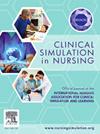增强同理心和理解:开发虚拟现实模拟,以教育医疗保健学生聋人患者的经历
IF 2.5
3区 医学
Q1 NURSING
引用次数: 0
摘要
耳聋患者在医疗环境中面临挑战,由于缺乏培训,在卫生专业项目中对耳聋的认识有限。医疗保健专业的学生缺乏如何与聋人有效沟通的准备,可能不理解或同情他们在医疗保健环境中的经历。本研究的目的是在聋人经历的基础上,共同设计和开发一个360度的VR模拟,以提高卫生专业学生在与聋人患者一起工作时的同理心和理解能力。样本研究样本由在英国威尔士一所大学就读本科学位的预注册医疗保健专业学生(n = 8)组成。参与者是通过电子邮件邀请健康与社会护理学院的所有学生招募的。方法采用以用户为中心的设计方法,分为三个阶段:收集聋人社区对医疗体验的反馈,设计和开发沉浸式360度视频VR,并通过前后调查和焦点小组对卫生专业学生(n = 8)进行评估。调查采用描述性统计分析,焦点小组记录采用专题分析分析。结果参与的学生的积极反馈强调了模拟的好处,以及它对生活体验的吸引力和影响力。结论模拟教学是培养学生为聋人工作做好准备和增强共情能力的有效工具。本文章由计算机程序翻译,如有差异,请以英文原文为准。
Enhancing empathy and understanding: Developing a virtual reality simulation to educate healthcare students on deaf patient experiences
Background
Deaf patients face challenges in healthcare settings, with limited deaf awareness in health professional programs, due to a lack of training. Healthcare professional students lack preparation about how to communicate effectively with deaf people and may not understand or empathize with their experiences in healthcare settings. The aim of the study was to co-design and develop a 360-degree VR simulation, informed by deaf patient experiences, to enhance health professional students’ empathy and understanding when working with deaf patients.
Sample
Study sample was comprised of a purposive sample of preregistration healthcare professional students (n = 8) enrolled in an undergraduate degree at one university in Wales, UK. Participants were recruited through email invitation to all students in one School of Health and Social Care.
Methods
A user-centered design approach was used across three phases: gathering feedback from deaf communities on healthcare experiences, design and development of an immersive 360-degree video VR, and evaluating it with health professional students (n = 8), through a pre/post survey and focus group. The survey was analyzed using descriptive statistics and the focus group transcript analyzed using thematic analysis.
Results
Positive feedback from participating students emphasized the benefits of the simulation and its engaging, impactful nature with a focus on lived experience.
Conclusion
Simulation education is an effective tool in preparing students for working with deaf patients and in enhancing empathy.
求助全文
通过发布文献求助,成功后即可免费获取论文全文。
去求助
来源期刊

Clinical Simulation in Nursing
NURSING-
CiteScore
5.50
自引率
15.40%
发文量
107
期刊介绍:
Clinical Simulation in Nursing is an international, peer reviewed journal published online monthly. Clinical Simulation in Nursing is the official journal of the International Nursing Association for Clinical Simulation & Learning (INACSL) and reflects its mission to advance the science of healthcare simulation.
We will review and accept articles from other health provider disciplines, if they are determined to be of interest to our readership. The journal accepts manuscripts meeting one or more of the following criteria:
Research articles and literature reviews (e.g. systematic, scoping, umbrella, integrative, etc.) about simulation
Innovative teaching/learning strategies using simulation
Articles updating guidelines, regulations, and legislative policies that impact simulation
Leadership for simulation
Simulation operations
Clinical and academic uses of simulation.
 求助内容:
求助内容: 应助结果提醒方式:
应助结果提醒方式:


